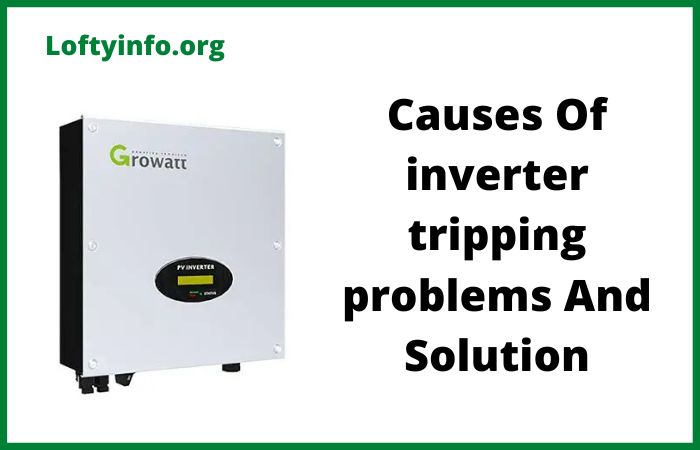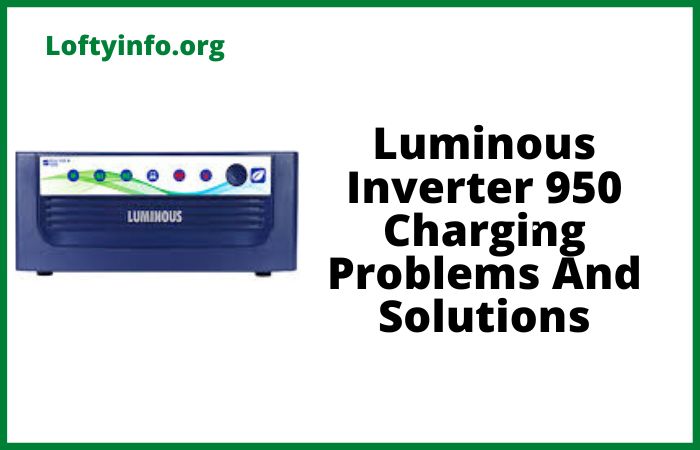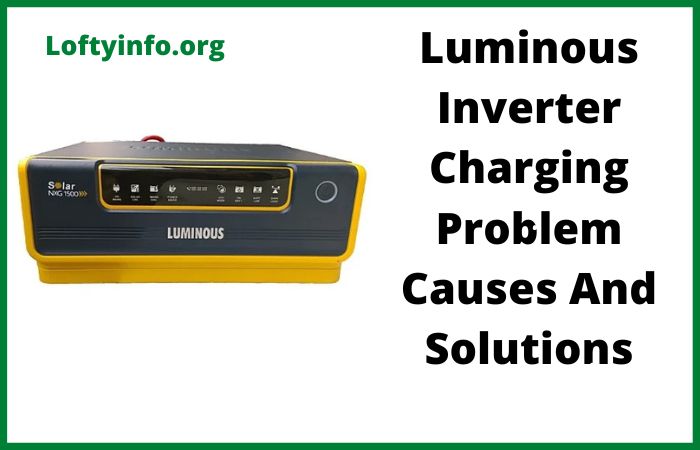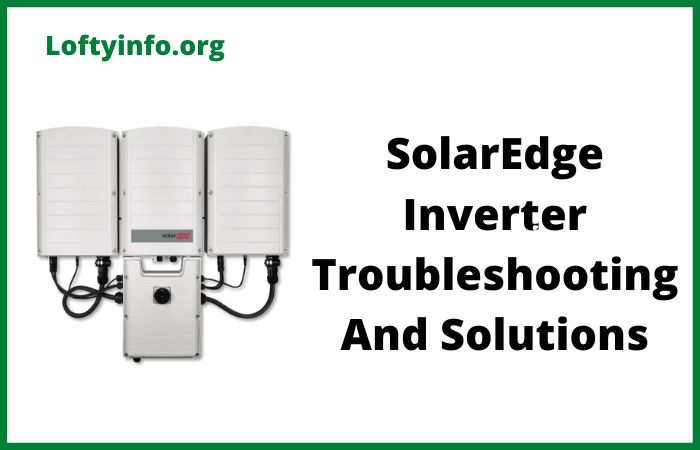Common Solax Inverter Problems and Solutions
Solax inverters have become popular choices for residential and commercial solar installations worldwide.
Founded in 2010, Solax launched its first solar inverters for the UK market in 2015 and has since expanded globally.
While these inverters are known for their reliability and performance, users occasionally encounter technical issues that can disrupt power generation.
Understanding these common problems and their solutions can save you time and money while keeping your solar system running efficiently.
Common Solax Inverter Problems
1) Battery Charging Issues
One of the most frequently reported problems with Solax inverters involves batteries that refuse to charge properly despite adequate solar generation.
Many users discover that their batteries remain at low charge levels even when their solar panels are producing significant power, sometimes ranging from 2kW to 4kW during peak hours.
The underlying cause often relates to incorrect configuration settings within the inverter system. Work mode settings may be improperly configured, preventing the inverter from directing power to the batteries.
Charge time settings can also be incorrectly programmed, which stops the charging process during crucial periods. In some installations, the battery management system may have entered a protective mode after complete discharge, essentially shutting down to prevent damage.
To resolve battery charging problems, start by accessing your inverter settings through the Solax Cloud app or the inverter’s LCD screen.
Verify that the work mode is set to self use rather than other modes that prioritize grid export. Check the charge time settings to ensure they align with your energy needs and solar production hours.
If your battery has completely discharged, you may need to restart the entire system by turning off the battery switch located on the master battery, waiting a few minutes and then turning it back on.
For hybrid inverters, you can also use the forced charge option during off-peak electricity hours to restore battery charge levels.
2) Grid Voltage Faults
Grid voltage faults represent another common issue that frustrates Solax inverter owners. These faults typically appear as error codes such as AC5M Volt Fault, AC10M Volt Fault or GridVoltFault on the inverter display.
Users often receive multiple fault notifications throughout the day, even when other appliances in their homes operate normally.
This problem occurs when the inverter measures AC voltage levels that fall outside its programmed safe operating parameters.
The issue can stem from several sources including actual grid voltage fluctuations in your area where supply voltage temporarily exceeds safe thresholds.
Inadequate wiring between the inverter and the main switchboard can cause voltage drops or spikes, particularly if cables are undersized for the power load.
The inverter’s internal voltage measurement calibration may also be slightly inaccurate, causing it to register voltages that differ from actual levels by several volts.
Addressing grid voltage faults requires a systematic approach.
First, use a quality multimeter to measure the actual voltage at your inverter’s AC connection point and compare it with the voltage reading displayed on your inverter or in the Solax Cloud app.
If you notice a discrepancy of more than 3 volts, the inverter may need calibration adjustment.
Check whether your AC cables are appropriately sized for your system’s power output. Installations with undersized cables often experience voltage issues and may require upgrading to larger gauge wiring.
If measurements confirm that your local grid voltage regularly exceeds the inverter’s threshold settings, you can adjust the grid protection voltage parameters through the advanced settings menu by increasing the overvoltage limit by 5 volts at a time until the faults stop occurring.
3) Communication and Connectivity Problems
Many Solax inverter owners struggle with connectivity issues that prevent remote monitoring and control.
These problems manifest as inverters that fail to connect to WiFi networks, dongles that show incorrect status lights or mobile apps that display invalid registration errors despite multiple setup attempts.
Communication failures typically result from several factors. WiFi dongles may not be properly registered to your specific inverter in the Solax system database.
Incorrect network configuration settings can prevent the dongle from connecting to your home router. In some cases, previous owners or installers may not have properly unbound old dongles from the system before new ones were installed.
Physical connection issues such as loose cables or damaged dongle units can also interrupt communication.
To fix connectivity problems, begin by verifying that the WiFi dongle is securely connected to the appropriate port at the bottom of your inverter.
The dongle should display a solid red or green light depending on its model and version to indicate an active connection. If you cannot access the inverter’s configuration page using the default IP address of 5.8.8.8, try connecting directly to the inverter’s WiFi network before attempting to bridge it to your home network.
Contact Solax technical support with your inverter’s serial number and installation address to confirm that any old dongles have been properly unbound from the system and that your new dongle is correctly registered.
Ensure your firmware is updated to the latest version, as outdated software can cause compatibility issues with newer dongle models.
4) GFCI and Ground Fault Issues
Ground fault circuit interrupter errors are serious problems that can completely shut down your solar system.
When a GFCI fault occurs, the inverter detects what it interprets as dangerous leakage current flowing to ground and immediately stops operation to prevent potential electrical hazards.
These faults arise from actual electrical leakage in your DC wiring or solar panel connections where damaged insulation or moisture ingress creates unintended current paths to ground. Internal component failures within the inverter itself can trigger false GFCI readings.
The capacitive coupling between solar panels and grounding systems can also generate AC leakage currents that the inverter mistakes for genuine ground faults, particularly in certain panel types and mounting configurations.
Resolving GFCI faults demands careful electrical investigation.
Completely shut down your solar system using both AC and DC isolators before beginning any inspection.
Visually examine all DC cables running from your solar panels to the inverter for signs of damage including cracked insulation, exposed conductors or water infiltration in junction boxes.
Use a megger or insulation resistance tester to check for leakage between the DC positive and negative conductors and ground, looking for readings that should typically exceed several megohms.
If the problem persists after eliminating external wiring issues and the inverter continues to generate GFCI faults following a complete system restart, the inverter likely has an internal component failure requiring professional repair or replacement under warranty.
5) Inverter Stuck in Waiting Mode
A particularly frustrating problem occurs when Solax inverters display a waiting message and refuse to begin power conversion despite apparent normal conditions. The inverter shows that it is receiving DC voltage from the solar panels but will not start up and begin feeding power to your home or the grid.
This waiting mode typically indicates that the inverter cannot detect proper startup conditions.
DC voltage from the solar panels may be below the minimum threshold required for inverter operation, which commonly happens during low light conditions at dawn or dusk or when panels are partially shaded.
Reversed polarity in DC wiring connections will prevent startup and may display negative voltage readings. The AC connection may have issues with isolators or circuit breakers in the off position, preventing the inverter from sensing grid presence.
In battery-equipped systems, communication failures between the inverter and battery management system can trigger waiting mode.
To escape waiting mode, verify that all DC isolator switches between your solar panels and inverter are in the on position.
Measure DC voltage at the inverter input terminals using a multimeter with the red probe on the positive terminal and black probe on the negative terminal.
You should see a positive voltage reading within the inverter’s maximum power point tracking range, typically showing 30 to 60 volts per panel multiplied by the number of panels in series.
If you measure a negative voltage, your DC wiring has reversed polarity and needs immediate correction by a qualified electrician.
Check that all AC isolators, miniature circuit breakers and residual current devices are switched on.
For battery systems, try performing a black start by disconnecting both solar and AC power, then starting the inverter using only battery power to verify the inverter’s basic functionality.
Prevention and Maintenance Tips
Preventing problems before they occur is always preferable to troubleshooting failures. Regular visual inspections of your inverter every few months can identify issues early.
Look for error messages on the display, unusual sounds or excessive heat generation.
Keep the area around your inverter clear of debris and ensure adequate ventilation to prevent overheating.
Monitor your system performance through the Solax Cloud app to quickly spot drops in generation that might indicate developing problems.
Ensure your inverter firmware stays current by checking for updates several times per year. Firmware updates often include bug fixes and performance improvements that prevent known issues.
Keep detailed records of your system’s installation parameters, configuration settings and any modifications made over time. This documentation proves invaluable when troubleshooting problems or working with technical support.
While Solax inverters come with manufacturer warranties typically lasting 10 years, understanding common problems and their solutions empowers you to maintain optimal system performance.
Some issues require simple configuration changes you can handle yourself, while others demand professional assistance from qualified solar technicians.
Recognizing the difference protects both your safety and your investment.
When problems persist despite troubleshooting attempts, never hesitate to contact Solax technical support or certified solar installers who have the expertise and equipment to diagnose and repair complex faults safely and effectively.
Best off grid solar setup between 12v, 24v and 48v
Common solutions to Exide inverter 850m VA overload problems
Why is Inverter showing low battery but not charging
Why your inverter fuse keeps blowing frequently
Why inverter outputs low voltage
Livguard inverter battery not charging problem
Why true power inverter overload problems occur
Luminous inverter 1650 overload problems and solutions
Common luminous zelio 1100 inverter overload problems explained
Causes of Luminous inverter 650 overload problems
Why common deye inverter problems occur
Common goodwe inverter problems and solutions guide
Common sungrow inverter problems and solutions explained
Common growatt sp2000 problems
Causes of growatt inverter problems
Inverter battery charging problem causes and solutions
How to charge bike battery with inverter at home
Luminous inverter voltage fluctuation problem
Common 1586 international problems
Why luminous inverter suddenly stops working
Critical mistakes to avoid when connecting solar panels in series






